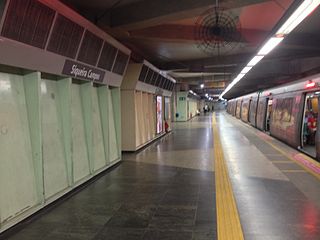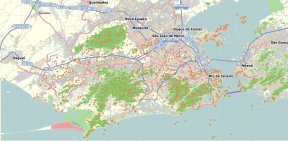
Rio de Janeiro, or simply Rio, is the capital of the state of Rio de Janeiro. It is the second-most-populous city in Brazil and the sixth-most-populous city in the Americas.

The Rio de Janeiro Metro, commonly referred to as just the Metrô is a rapid transit network that serves the city of Rio de Janeiro, Brazil. The Metrô was inaugurated on 5 March 1979, and consisted of five stations operating on a single line. The system currently covers a total of 58 kilometres (36 mi), serving 41 stations, divided into three lines: Line 1 ; Line 2, which together travel over a shared stretch of line that covers 10 stations of an approximate distance of 5 kilometres (3.1 mi); and Line 4. Metrô Rio has the second highest passenger volume of the metro systems in Brazil, after the São Paulo Metro.

The Porto Alegre Metro is a transit system operated jointly by the federal government, the state government of Rio Grande do Sul and the city of Porto Alegre through the company Trensurb in Brasil. It has 22 stations, totaling 43.8 kilometers (27.2 mi) of route, and carries about 175,000 users a day.

Cantagalo / Copacabana Station is a station on Line 1 of the Rio de Janeiro Metro located in the Copacabana borough of Rio de Janeiro, Brazil. The station was opened in 2007.

General Osório / Ipanema is a station on Line 1 of the Rio de Janeiro Metro located in the Ipanema borough of Rio de Janeiro, Brazil. It is the line's southern terminus. The station opened in December 2009.
Line 4 (Yellow) of the Rio de Janeiro Metro is the third metro line built in the city of Rio de Janeiro. It was completed on 30 July 2016, connecting the Barra da Tijuca neighbourhood in the West Zone, passing under São Conrado and Rocinha, to Ipanema in the South Zone. All stations are underground, but when arriving in Barra da Tijuca, trains exit a tunnel, pass briefly by an elevated bridge and go underground again.

Paulista-Pernambucanas is a metro station on Line 4-Yellow of the São Paulo Metro, operated by ViaQuatro, and it's located in the Consolação district. It has free connection with Consolação station of Line 2-Green, operated by São Paulo Metro. The station was renamed after a naming rights contract was signed between ViaQuatro and retail store company Pernambucanas in April 2023.
Tomás Coelho is a neighborhood in the North Zone of Rio de Janeiro, Brazil.

Botafogo Station is a subway station on the Rio de Janeiro Metro that serves the neighbourhood of Botafogo in the South Zone of Rio de Janeiro.

Cardeal Arcoverde / Copacabana Station is a subway station on the Rio de Janeiro Metro servicing the Copacabana area. It opened in July 1998.

Siqueira Campos / Copacabana Station is a subway station on the Rio de Janeiro Metro that services the neighbourhood of Copacabana in the South Zone of Rio de Janeiro. It is one of the busiest stations in the city, with an average daily flux of 76 thousand passengers.

Flamengo Station is a subway station on the Rio de Janeiro Metro that services the neighbourhood of Flamengo in the South Zone of Rio de Janeiro.

Largo do Machado Station is an underground station on the Rio de Janeiro Metro that services the neighbourhoods of Catete, Laranjeiras, Cosme Velho and Largo do Machado in the South Zone of Rio de Janeiro. It is located near the Estádio das Laranjeiras.

Afonso Pena / Tijuca Station is a subway station on the Rio de Janeiro Metro that services the neighbourhood of Tijuca in the North Zone of Rio de Janeiro.

São Francisco Xavier / Tijuca Station is a subway station on the Rio de Janeiro Metro that services the neighbourhood of Tijuca in the North Zone of Rio de Janeiro. It is located next to a church of the same name and the Teatro Ziembinski.

Saens Peña / Tijuca is a station on the Rio de Janeiro Metro that services the neighborhood of Tijuca in the North Zone of Rio de Janeiro.

São Cristóvão Station is a railway station in São Cristóvão, Rio de Janeiro which is serviced by the Rio de Janeiro Metro and SuperVia.

Terminal Alvorada is a bus station in Barra da Tijuca in the West Zone of Rio de Janeiro. The terminal was renovated in 2013.

Jardim Oceânico / Barra da Tijuca is a station on the Rio de Janeiro Metro that services the neighborhood of Barra da Tijuca in the West Zone of Rio de Janeiro. It was previously simply named Jardim Oceânico, but was renamed alongside many others in August 2022 to include its neighborhood, Barra da Tijuca, in the name.

Jardim de Alah / Leblon is a station on Line 4 of the Rio de Janeiro Metro located in the Leblon neighborhood of Rio de Janeiro, Brazil. The station opened alongside four others of Line 4 in late July 2016.



















